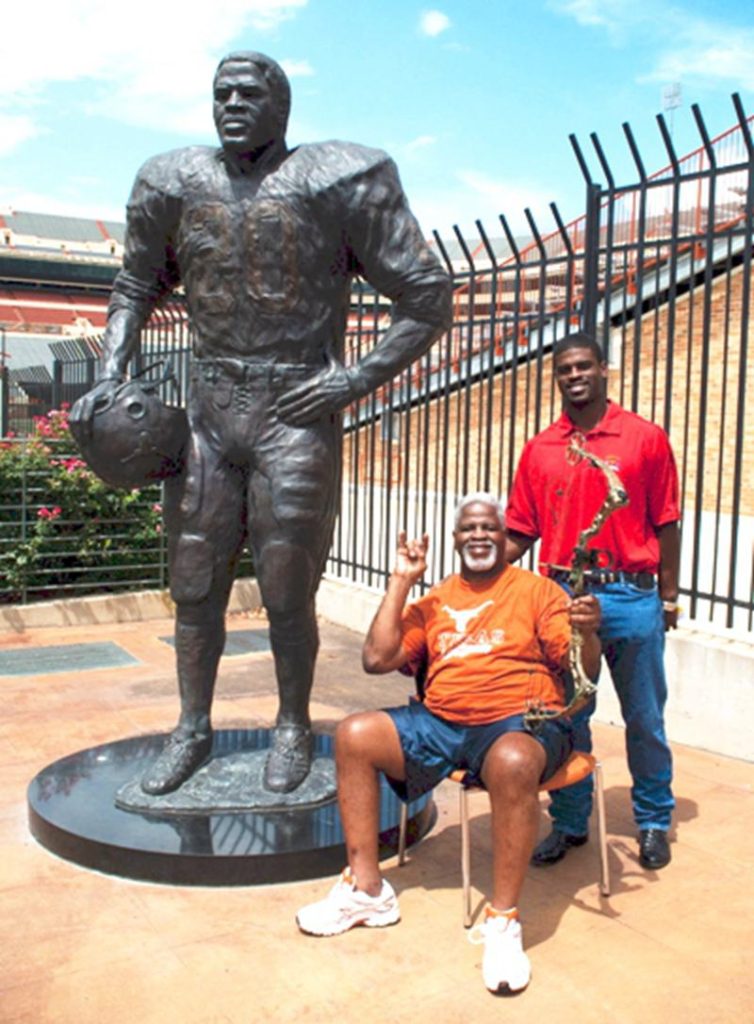
The Texas Longhorns will forever be linked with the great players who shaped their legendary football program, and none stand taller than Earl Campbell. This past week, it was announced that the University of Texas would honor the extraordinary career and legacy of Earl Campbell with a statue to be erected at Darrell K. Royal-Texas Memorial Stadium, ensuring that future generations of fans and players will know the incredible story of one of the greatest to ever wear the burnt orange.
This tribute, which will capture the essence of Campbell’s dominance on the football field, marks a long-overdue recognition for a player who transformed the game, the Texas Longhorns program, and the city of Austin. The statue will immortalize not just Campbell’s physical greatness but also his lasting influence on the culture of Texas football.
The Origins of Earl Campbell’s Legacy
Born on March 29, 1955, in Tyler, Texas, Earl Campbell was raised in a working-class family where football would become an outlet for his competitive spirit. Growing up in East Texas, Campbell’s natural talent was evident early on. His raw power, speed, and fierce will to win made him a standout in high school football. But it was his time at the University of Texas, from 1974 to 1977, where Campbell would go from a promising athlete to a football legend.
Campbell’s college career was extraordinary. Playing under legendary head coach Darrell K. Royal, Campbell quickly cemented his place as one of the most dominant running backs in college football history. In 1974, Campbell burst onto the scene as a freshman, gaining over 900 yards and showcasing a level of talent that had never been seen before in Austin.
It wasn’t just his on-the-field prowess that set him apart; it was his determination and physicality. Campbell played with an intensity that was rarely matched, and it soon became clear that he was on the path to greatness. As his career progressed, Campbell would solidify his place in the Longhorns’ record books. In his senior year, Campbell ran for an incredible 1,744 yards, helping lead the Longhorns to a Southwest Conference title and a berth in the 1978 Cotton Bowl.
One of Campbell’s most defining moments came in that 1977 season. The Longhorns finished with a 10-1-1 record, and Campbell was awarded the prestigious Heisman Trophy, given annually to the best player in college football. This was a testament to his dominance and the indelible mark he left on the sport. His Heisman win was a defining moment in Texas football history and helped elevate the Longhorns’ program to national prominence.
But beyond the stats, Campbell’s play captured the imagination of fans across the country. His rare combination of speed, power, and vision made him nearly unstoppable. The way he ran—constantly churning forward and dragging defenders with him—was the hallmark of a style of play that was both relentless and electrifying. His ability to break tackles and carry the ball for long, punishing runs became a spectacle that fans couldn’t get enough of.
The National Stage and the Texas Longhorns’ Iconic Legacy
When Earl Campbell left the University of Texas after his senior season, he was not only one of the most celebrated players in Longhorn history but also one of the most coveted players in all of college football. He had transcended the sport and was a symbol of the Texas Longhorns in the 1970s, representing the pinnacle of what college football could produce.
The Houston Oilers, now known as the Tennessee Titans, selected Campbell with the first overall pick in the 1978 NFL Draft, and his success continued at the next level. Campbell quickly became one of the NFL’s most dominant running backs, earning a spot in the Pro Football Hall of Fame after his retirement. His professional career further solidified his place in football lore, as he continued to carry the flag for the state of Texas, and his career numbers speak for themselves: 9,407 rushing yards, 74 touchdowns, and multiple All-Pro selections. Yet, despite his NFL success, it was his time at the University of Texas that remains his true football legacy.
At Texas, Campbell’s impact transcended his individual accomplishments. He played at a time when the Longhorns were building their dynasty, and his success helped define an era for the program. His Heisman win and dominance on the field elevated the university’s football stature and connected the state of Texas to a larger cultural force. It was more than just football—Earl Campbell became an ambassador for the university, for the sport, and for Texas football.
In Austin, he became a living legend, and the stories of his on-field exploits became the stuff of myth. His power runs through defenders, his electric open-field speed, and his unrelenting drive to succeed became synonymous with the Texas Longhorns football program. As the years went on, his legacy only grew stronger, as fans continued to revere him, even after he left the university and moved on to his professional career. When one speaks of Texas football, one speaks of Earl Campbell.
The Statue: A Tribute to Earl Campbell’s Enduring Legacy
The decision to erect a statue in Earl Campbell’s honor is a recognition of not only his incredible on-field contributions but also the broader cultural and historical impact he has had on the University of Texas and college football as a whole. The statue, to be unveiled at Darrell K. Royal-Texas Memorial Stadium, is more than just a symbol of individual achievement. It is a celebration of an entire era in Texas football history and a tribute to a player whose influence goes beyond the gridiron.
For many, this tribute was long overdue. While Campbell has been honored in various ways over the years—through jerseys retired, awards named in his honor, and his induction into the College Football Hall of Fame—the statue represents a more permanent, tangible recognition of the profound role he played in shaping the Longhorns’ program. The statue will serve as a reminder to all who walk past it, whether they are students, alumni, or fans of the game, of the extraordinary player who helped elevate Texas football to unprecedented heights.
The statue will likely depict Campbell in full stride, showcasing the power and grace that made him such a transcendent player. His trademark style—lowering his head and dragging defenders down the field while still maintaining incredible speed and balance—will undoubtedly be captured in the design. The imagery of Campbell in motion, moving forward with unstoppable momentum, will represent not just his playing style but also the unyielding spirit that defined his career.
But the statue also represents something more. It speaks to the enduring legacy of Texas football, and Campbell’s place as one of the central figures in the program’s rich history. His contributions to the university are not just measured in yards gained or touchdowns scored but in the pride and identity he helped instill in the Texas Longhorns. He wasn’t just a football player; he was an ambassador for the program, a symbol of what Texas football stands for.
The Meaning for Longhorn Fans and the Future of Texas Football
The unveiling of the statue will be an emotional moment for Texas fans, many of whom grew up watching Campbell play, hearing the stories of his greatness, and witnessing firsthand the impact he had on the program. For them, Campbell was more than just a legend; he was a living part of Texas football history. His story is woven into the very fabric of the Longhorns’ identity, and the statue will ensure that future generations will continue to hear those stories and feel the same sense of pride.
For the current generation of players, the statue will be a powerful reminder of the standard they are expected to uphold. Texas football is a program built on excellence, and Campbell’s legacy is a cornerstone of that tradition. As new players come through the program, they will look to Earl Campbell as a model of what it means to be a Texas Longhorn. His work ethic, his relentless pursuit of greatness, and his unwavering love for the game serve as an inspiration to anyone who dons the burnt orange.
The statue will also serve as a symbol of the bond between Texas football and the city of Austin. The Longhorns have always had a special connection to the community, and Campbell was a central figure in that relationship. He is a beloved figure not only for his accomplishments on the field but also for the way he represented the values of the university and the state of Texas. He was—and continues to be—a symbol of everything that makes Texas football so special: pride, passion, and a commitment to excellence.
An Unforgettable Tribute to a Football Legend
As the statue of Earl Campbell is erected at Darrell K. Royal-Texas Memorial Stadium, it will serve as an enduring tribute to a player whose contributions to Texas football are immeasurable. Earl Campbell’s greatness as a player, his influence on the program, and his cultural significance make him an icon in the world of college football. This statue will ensure that his legacy lives on forever, and it will be a reminder to every fan, player, and visitor that the University of Texas was once home to one of the greatest football players to ever grace the field. In the heart of Austin, the statue of Earl Campbell will stand tall, a permanent symbol of an extraordinary life and career that forever changed the Texas Longhorns and the game of football itself.





